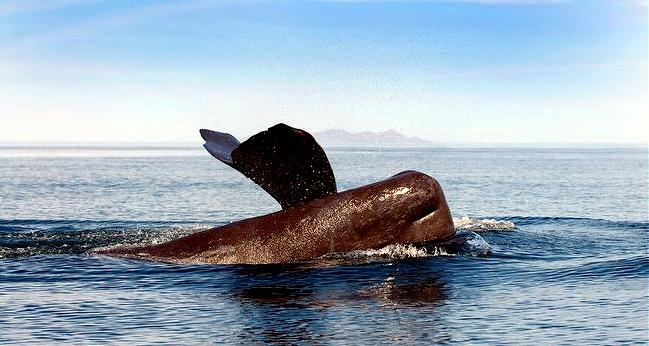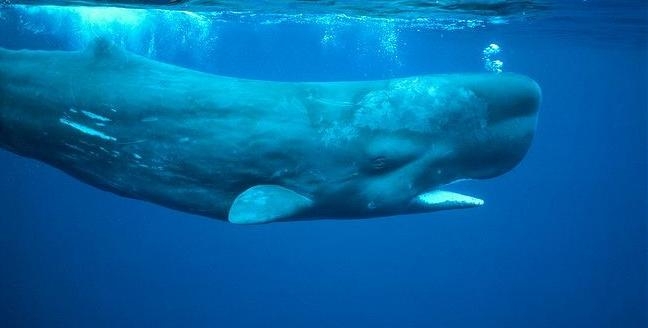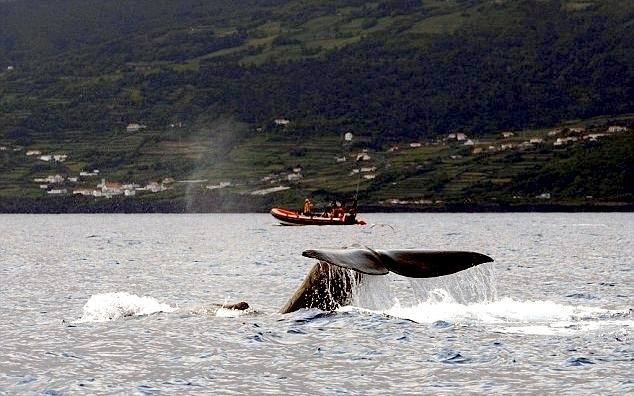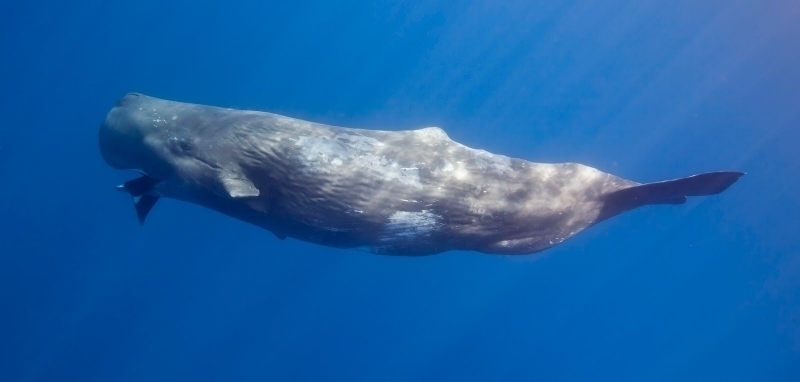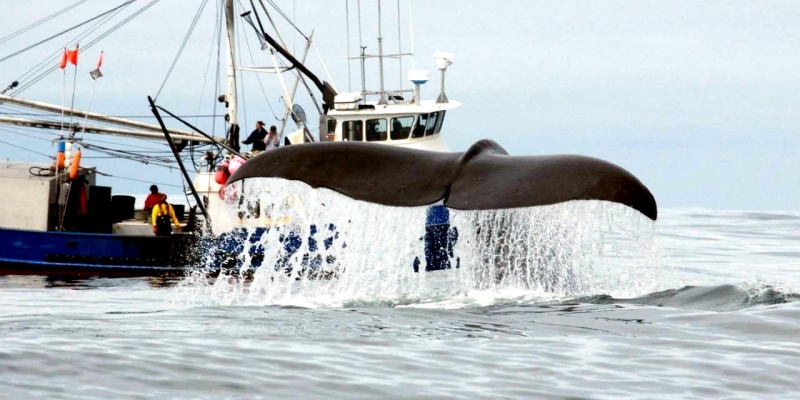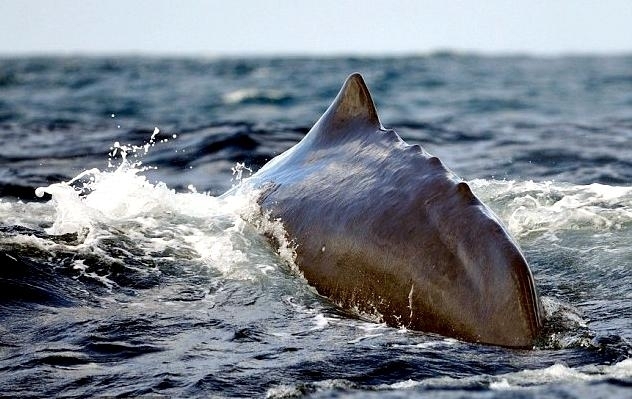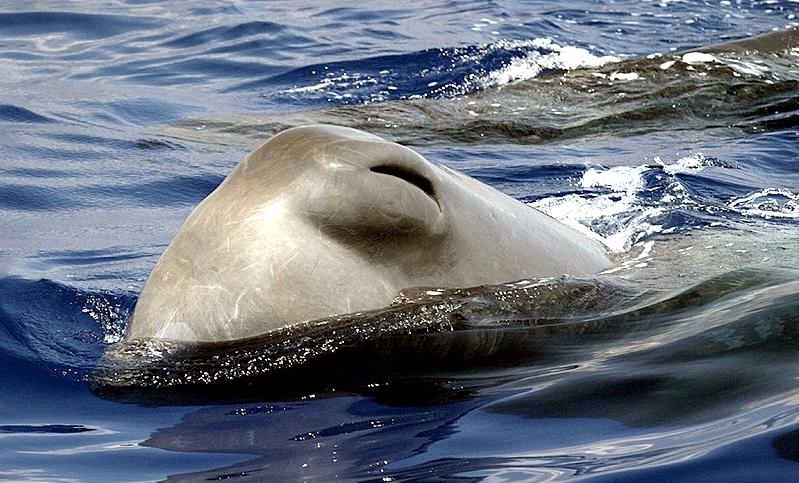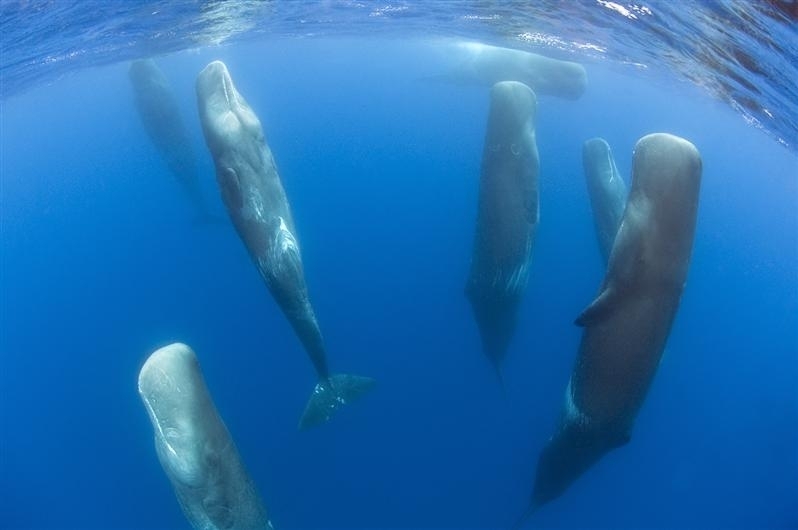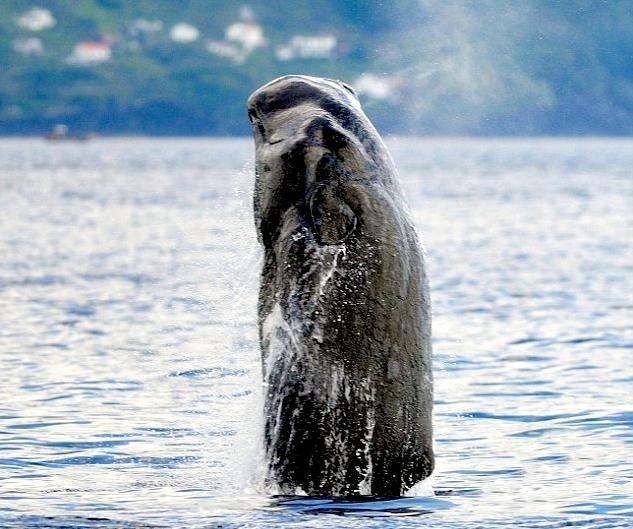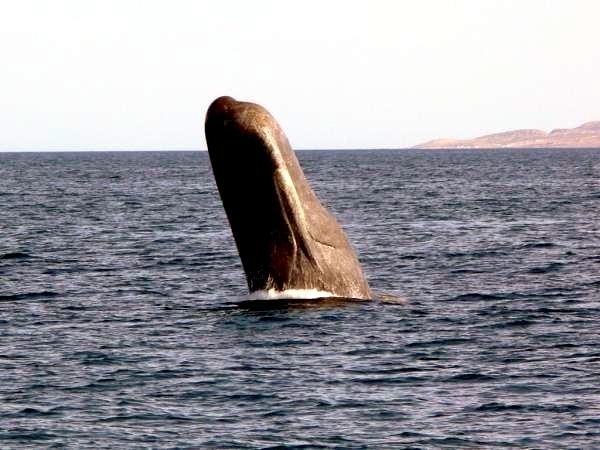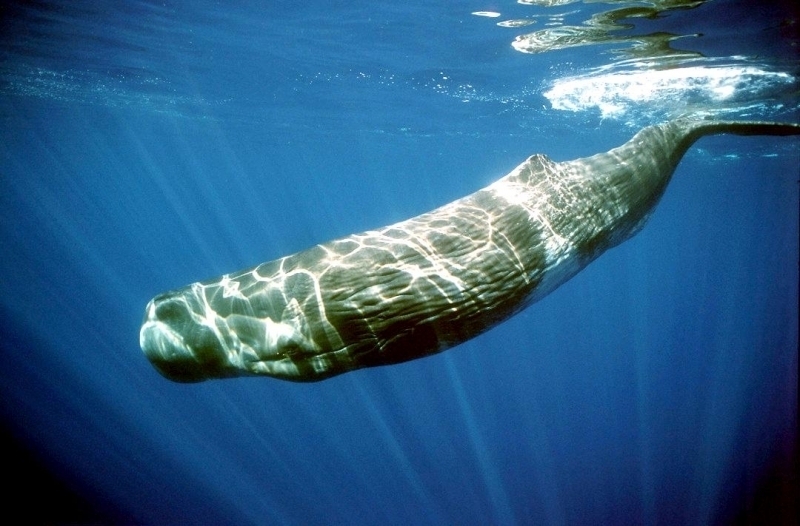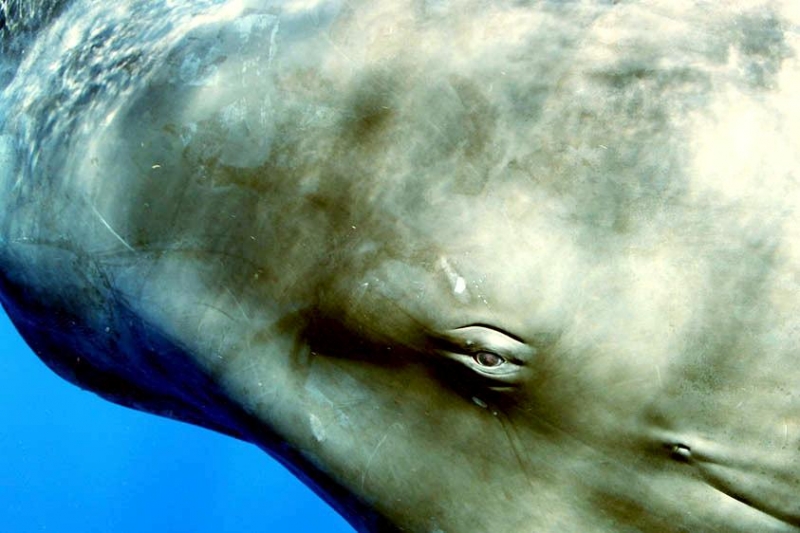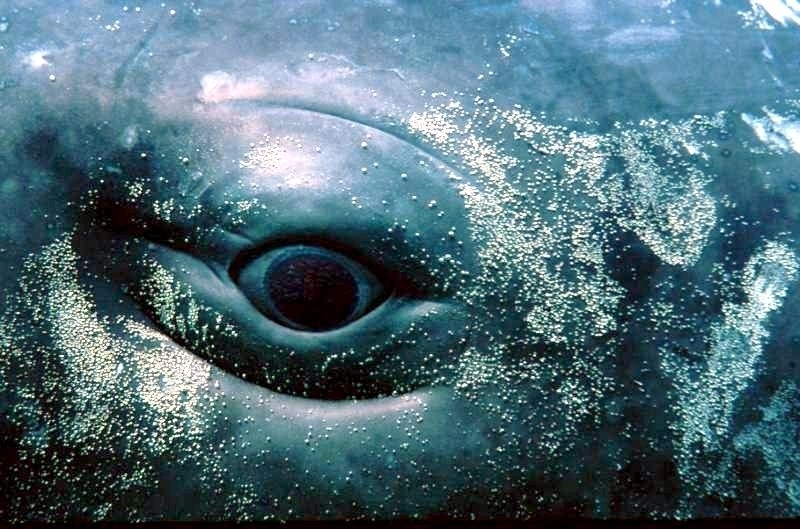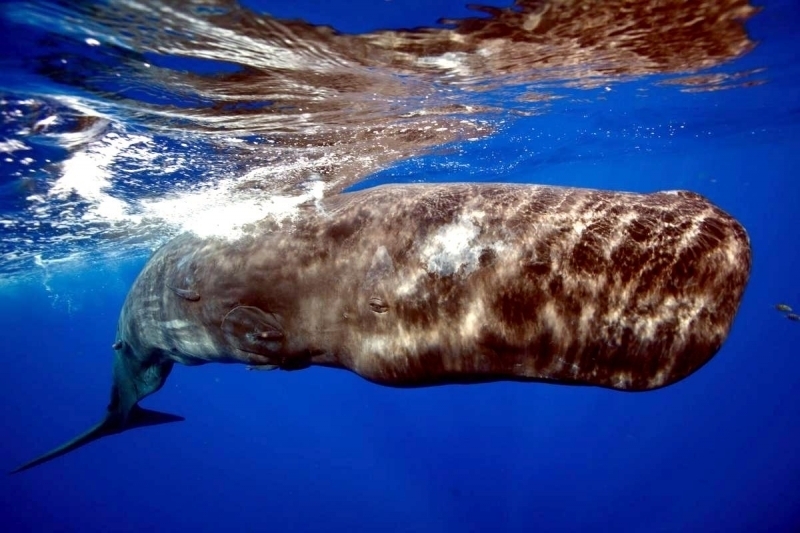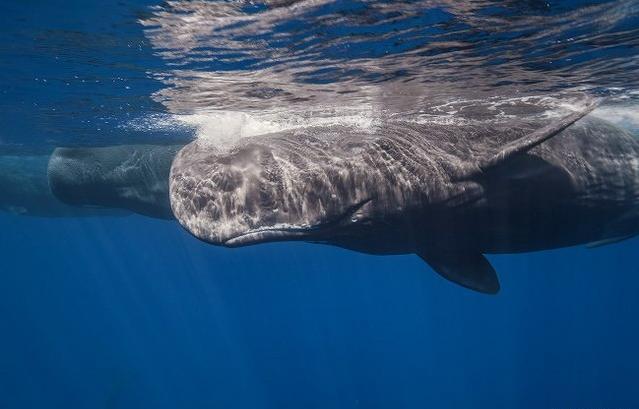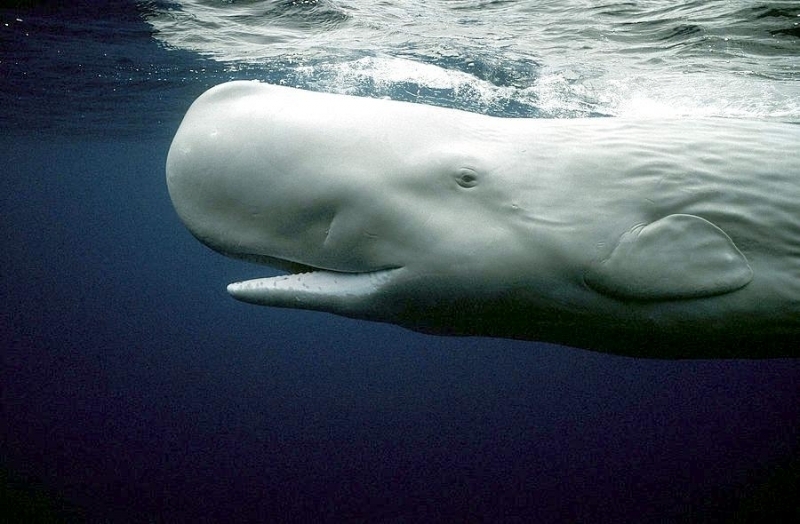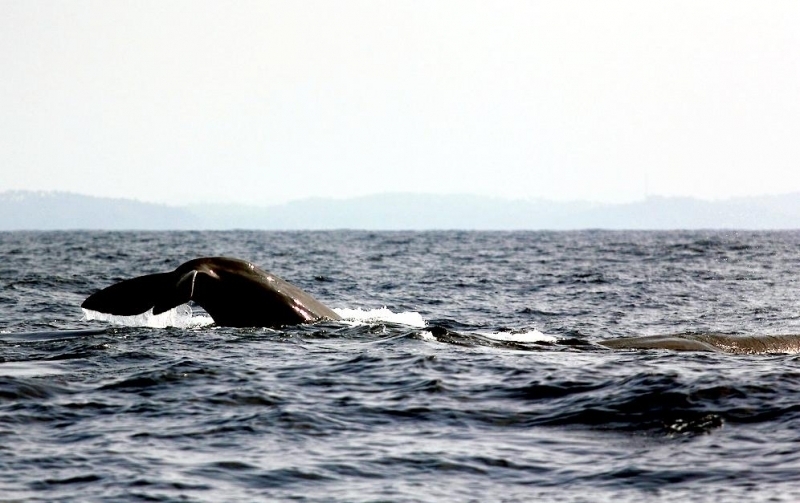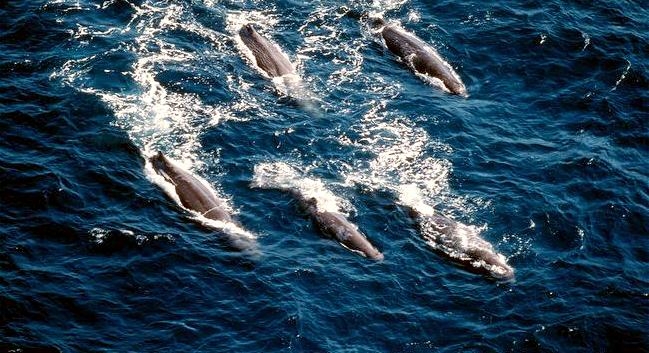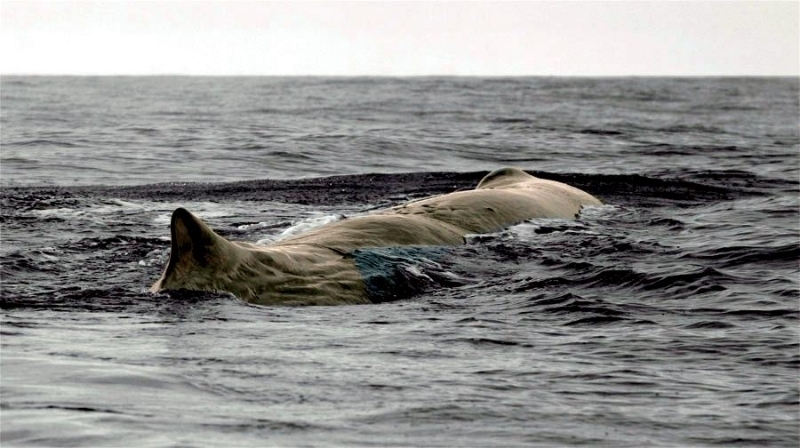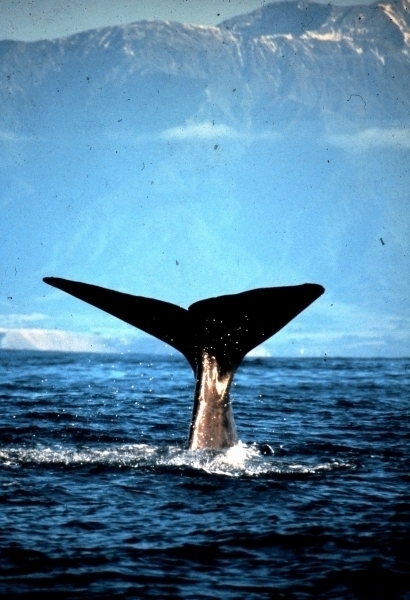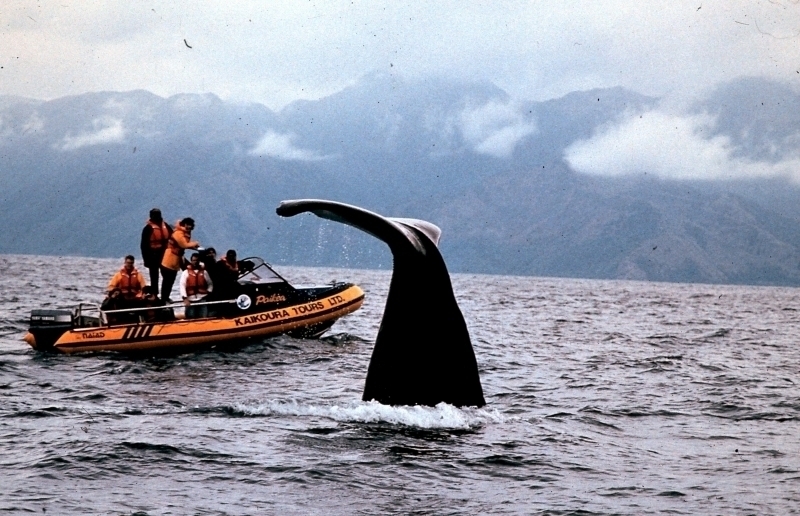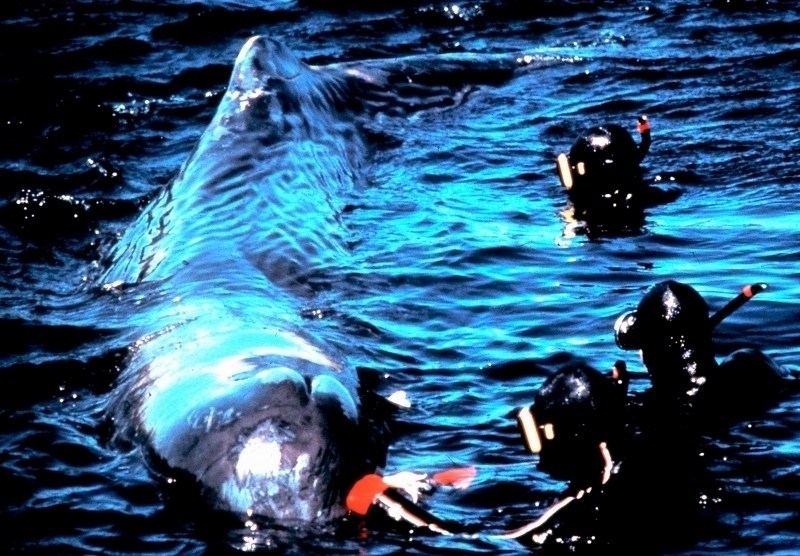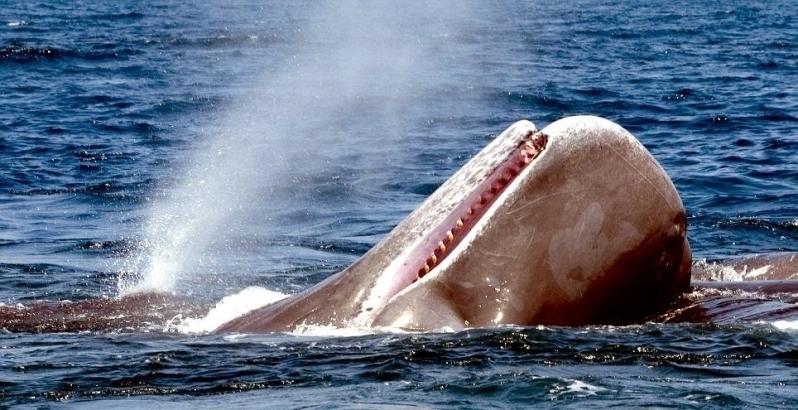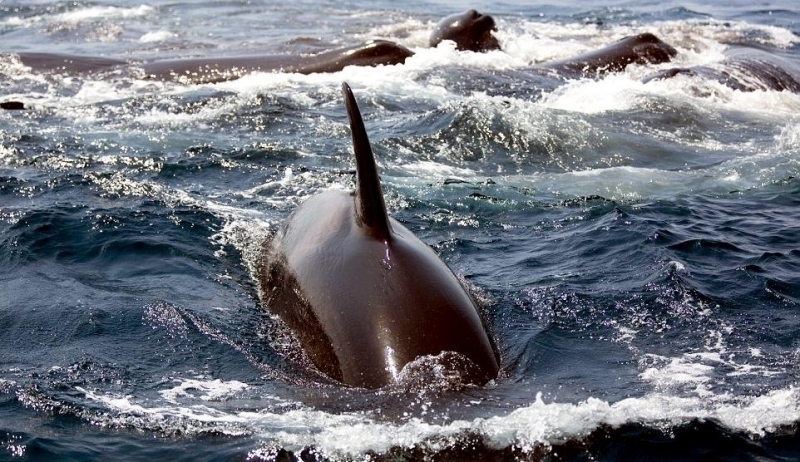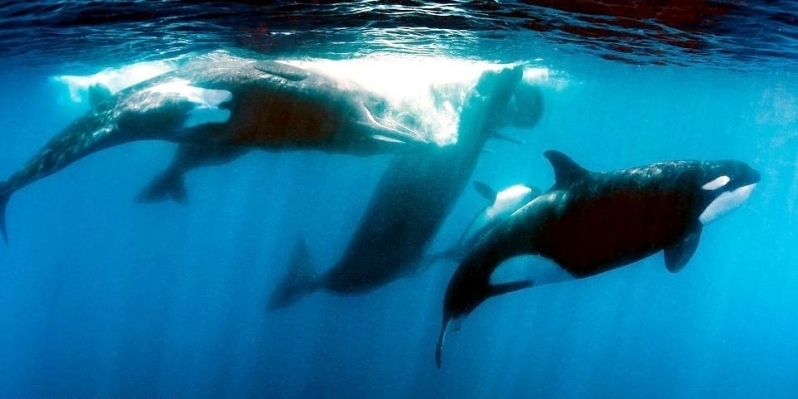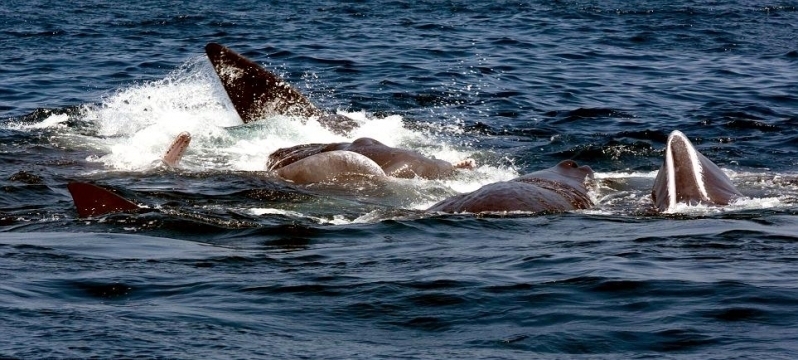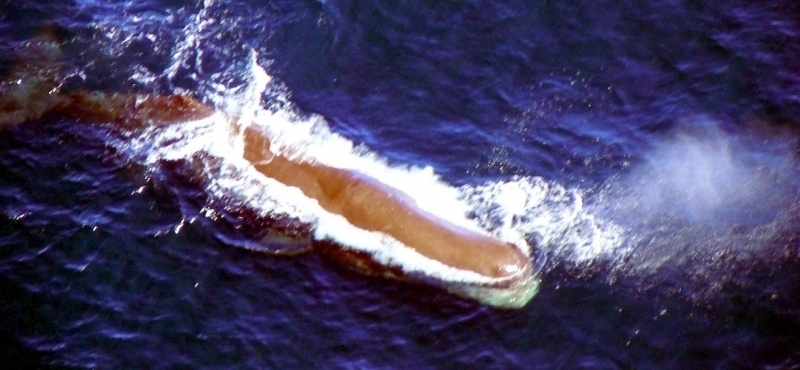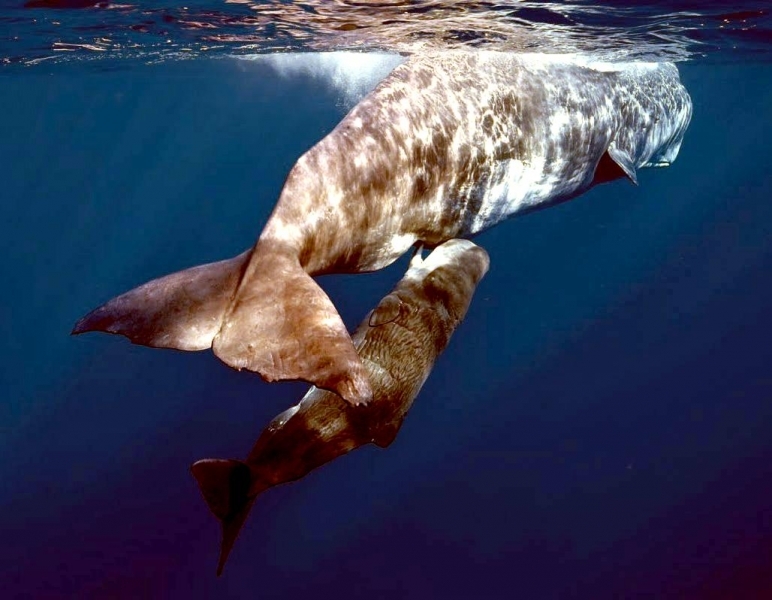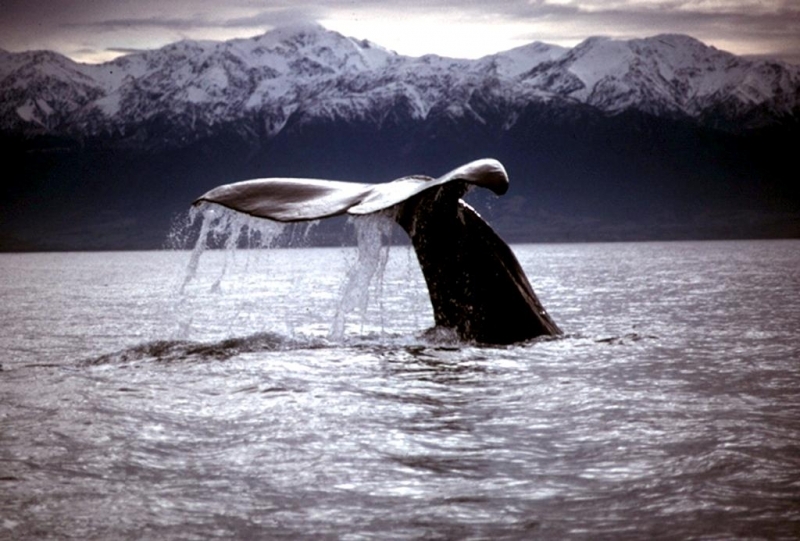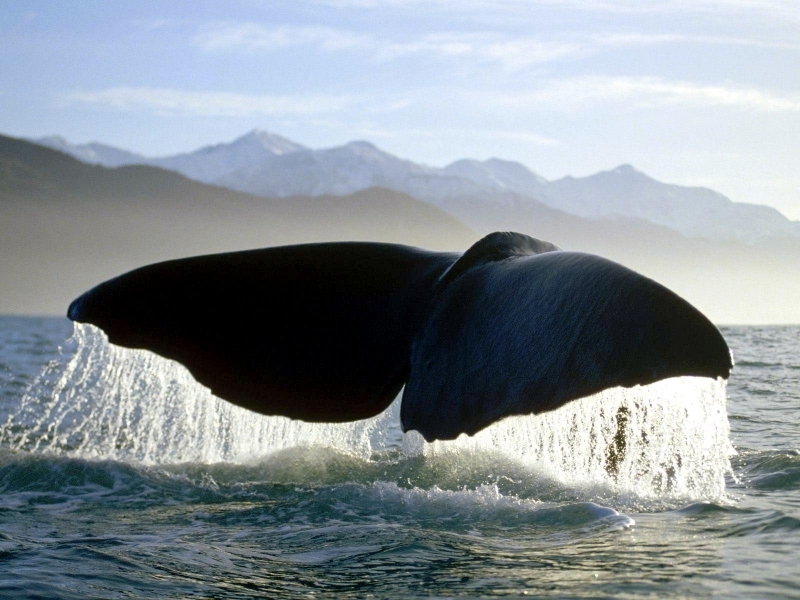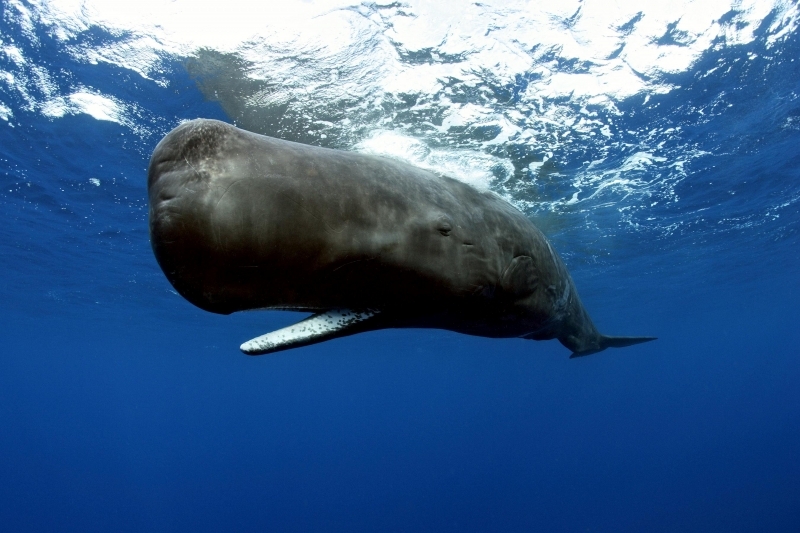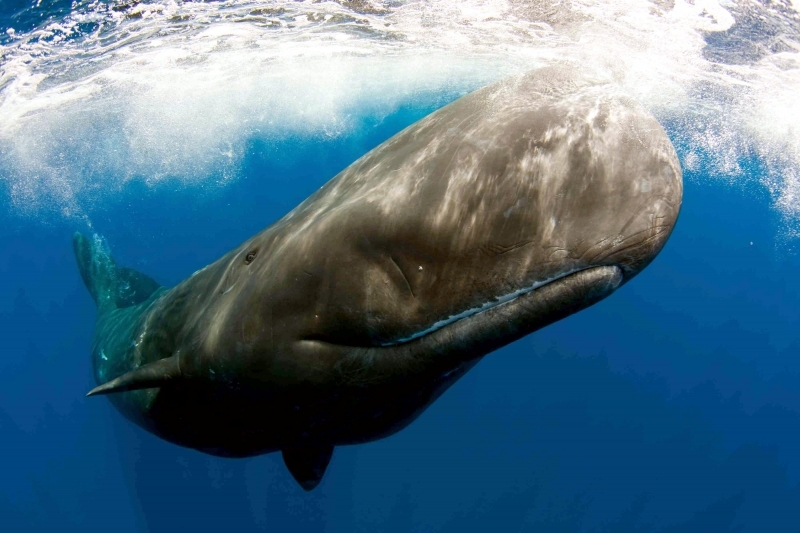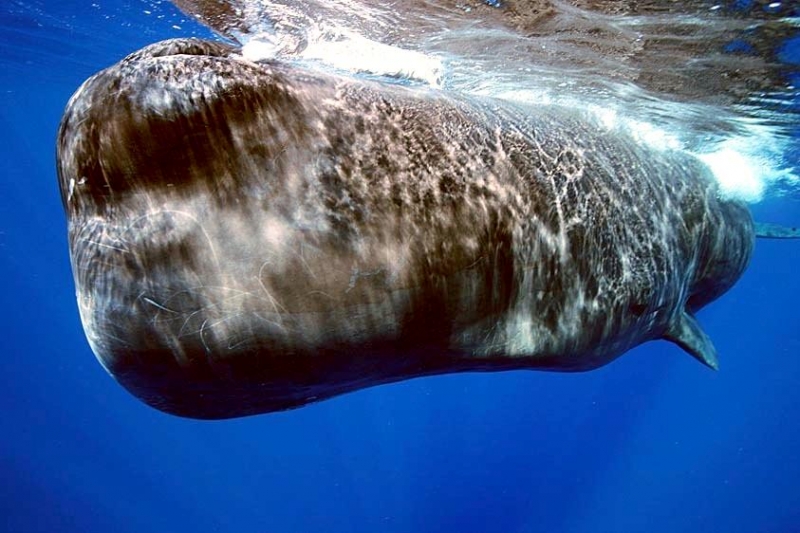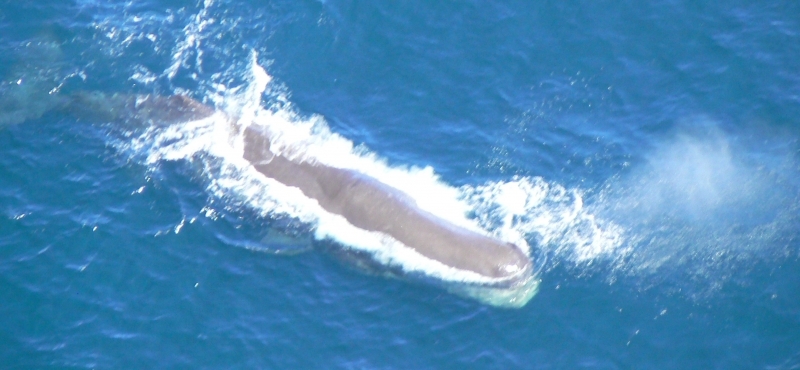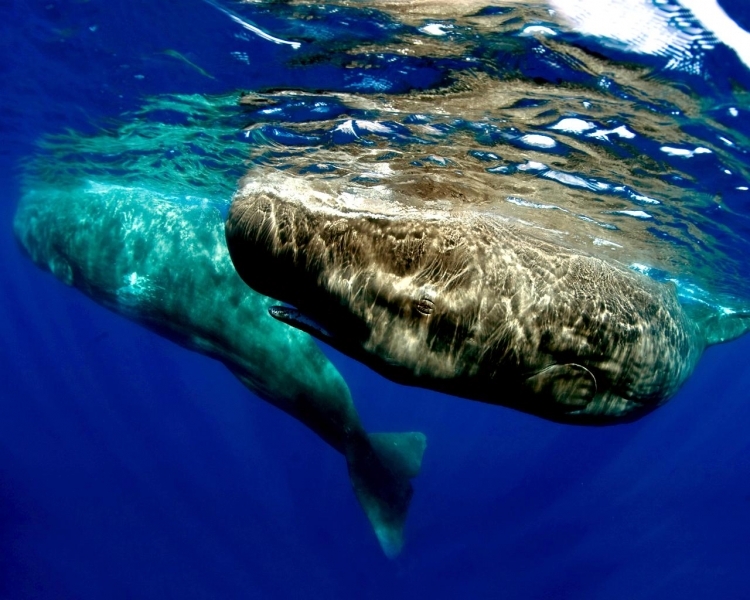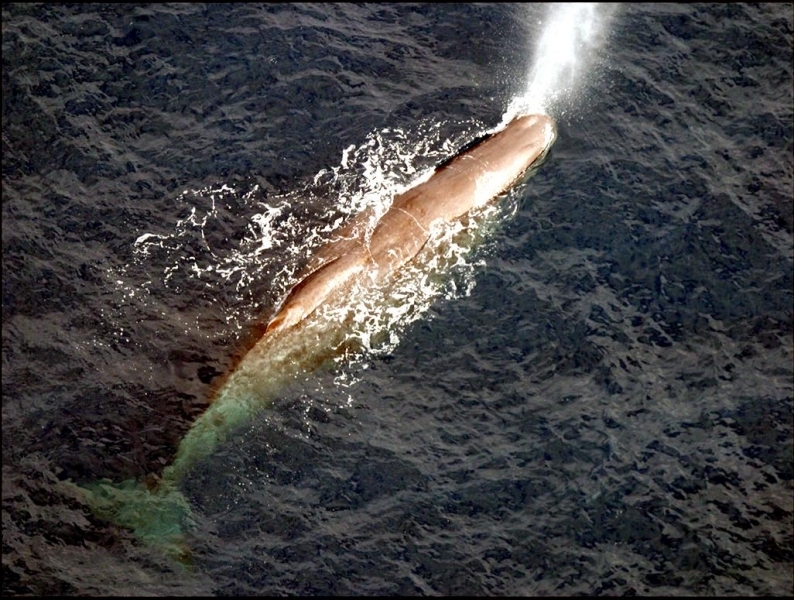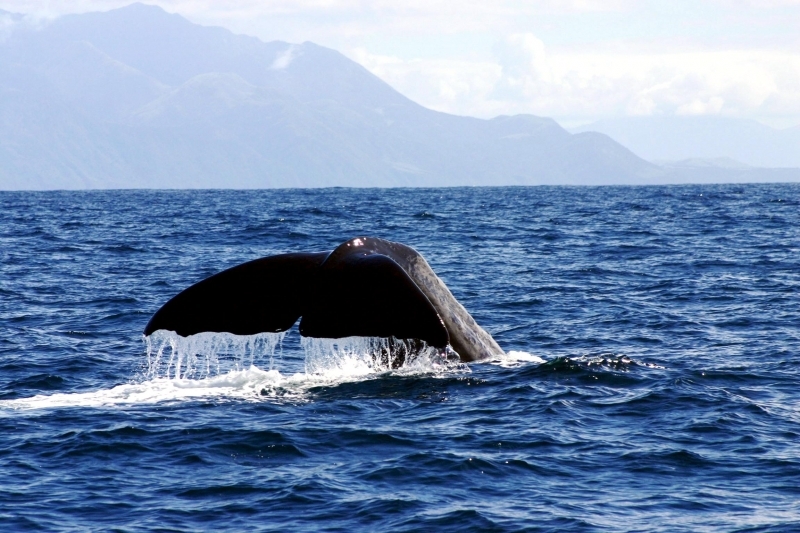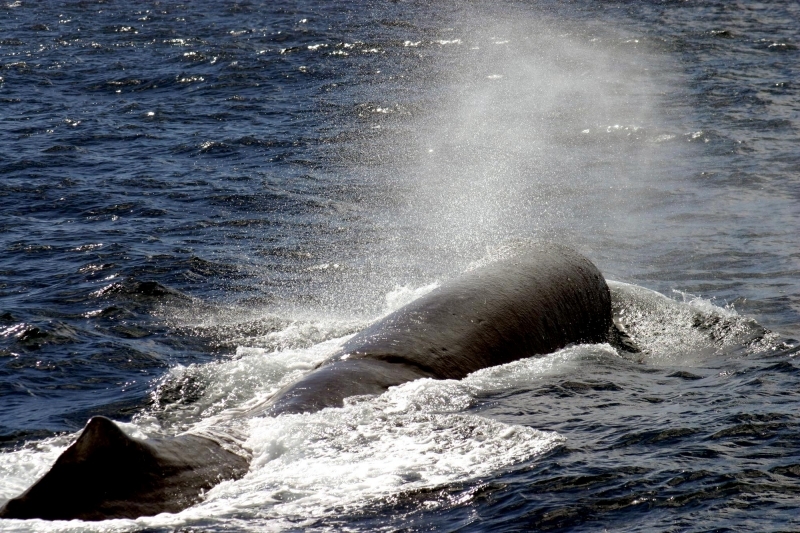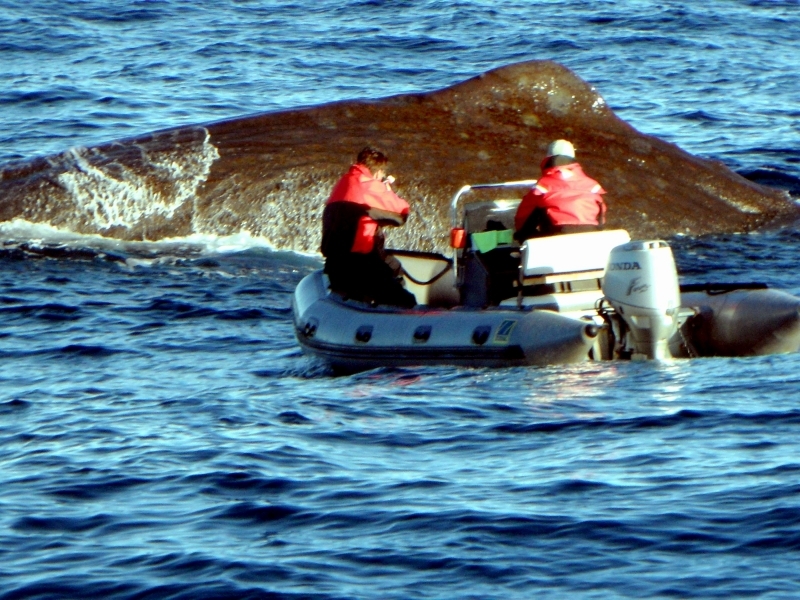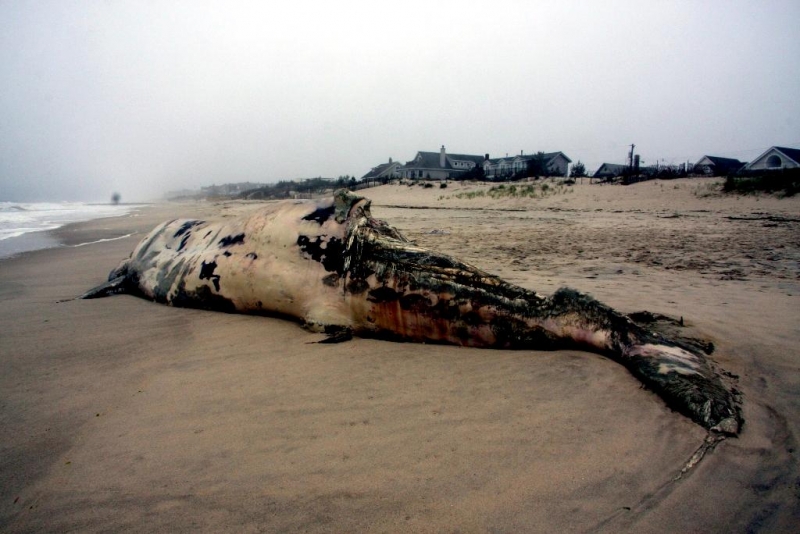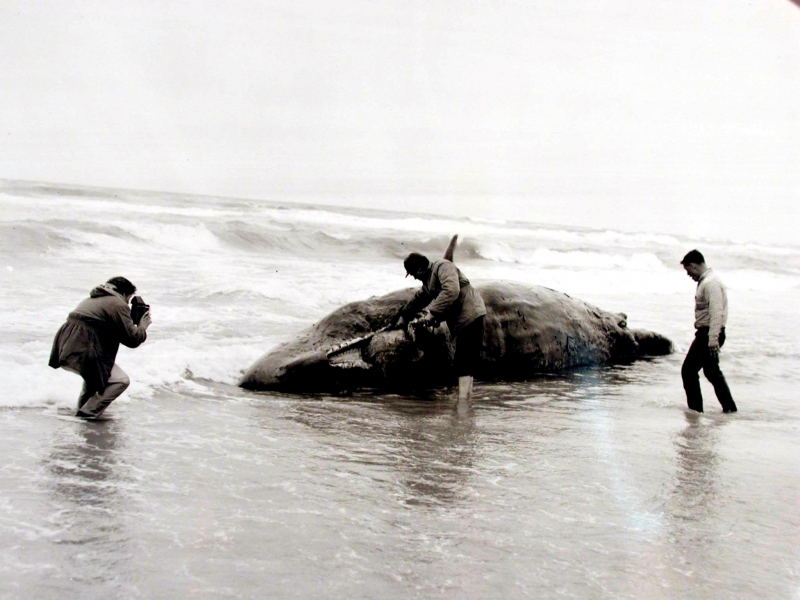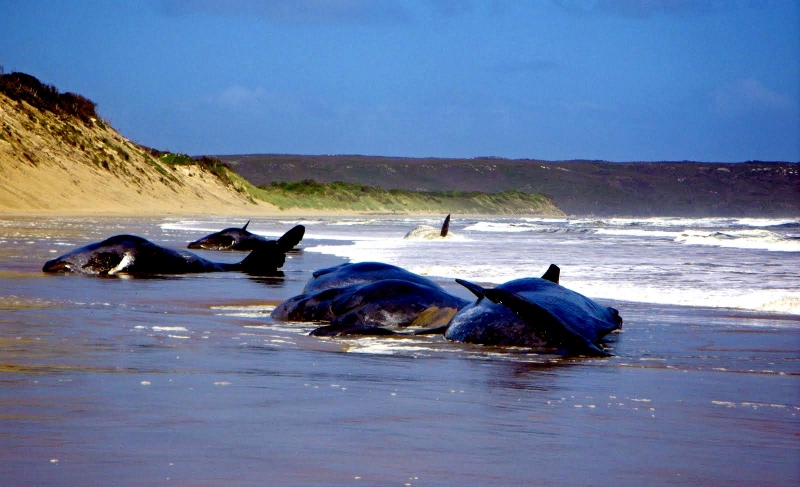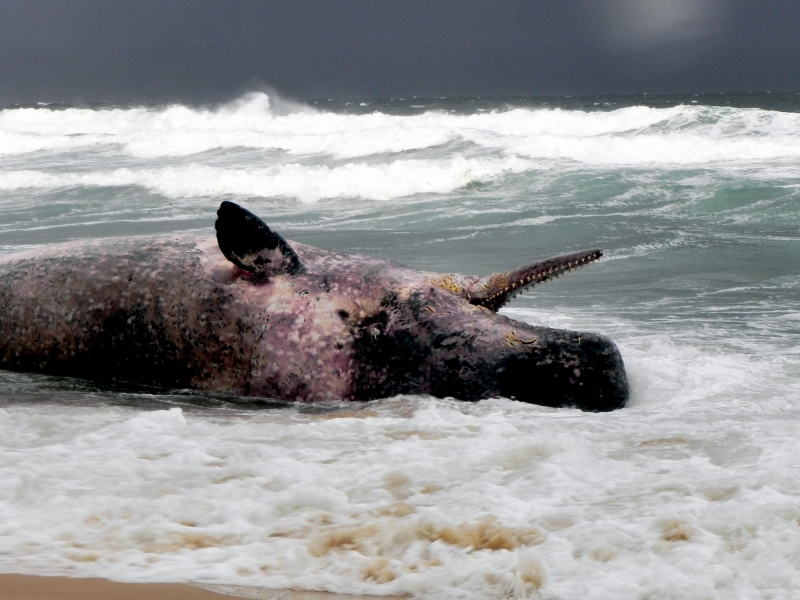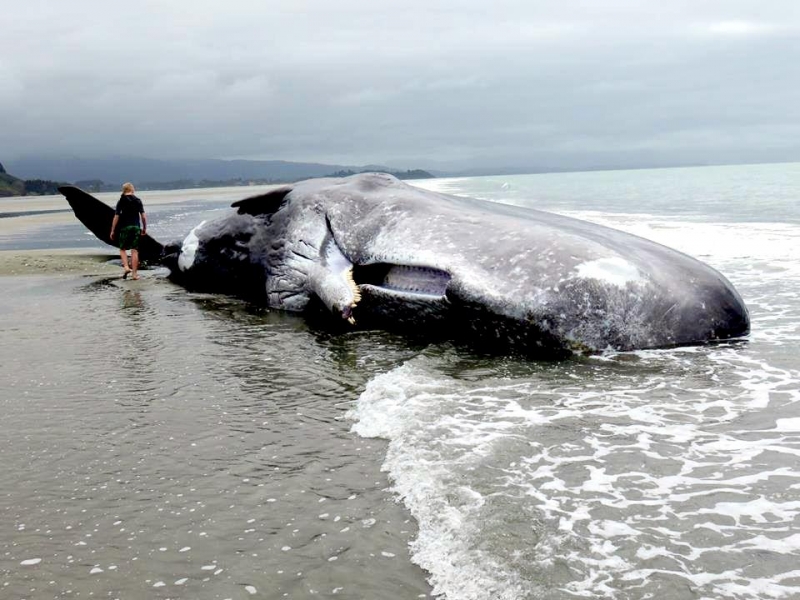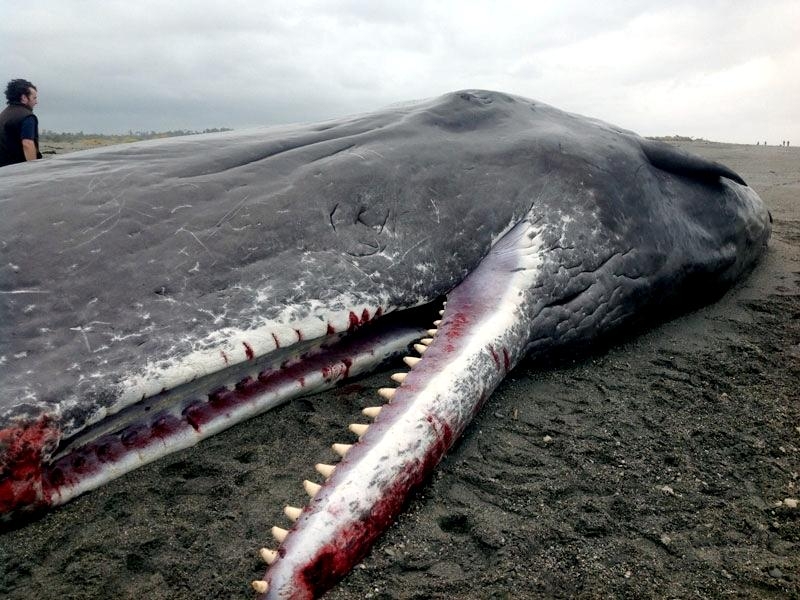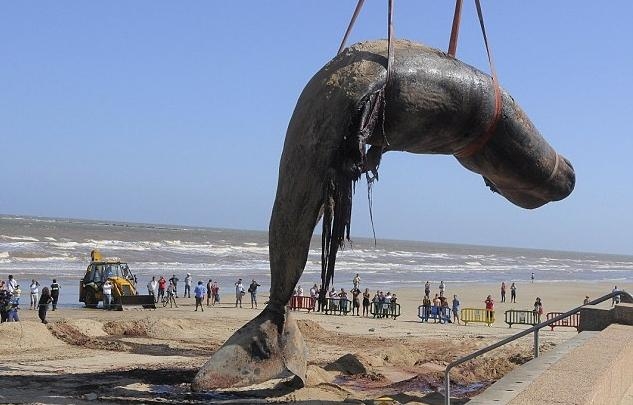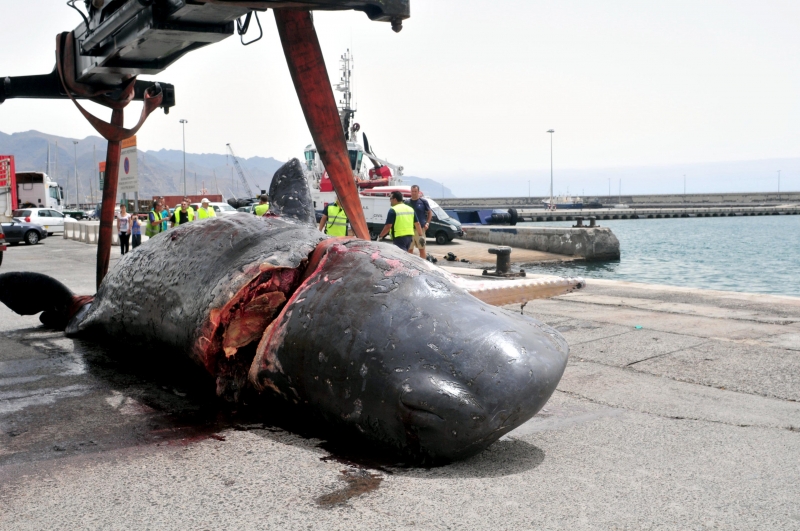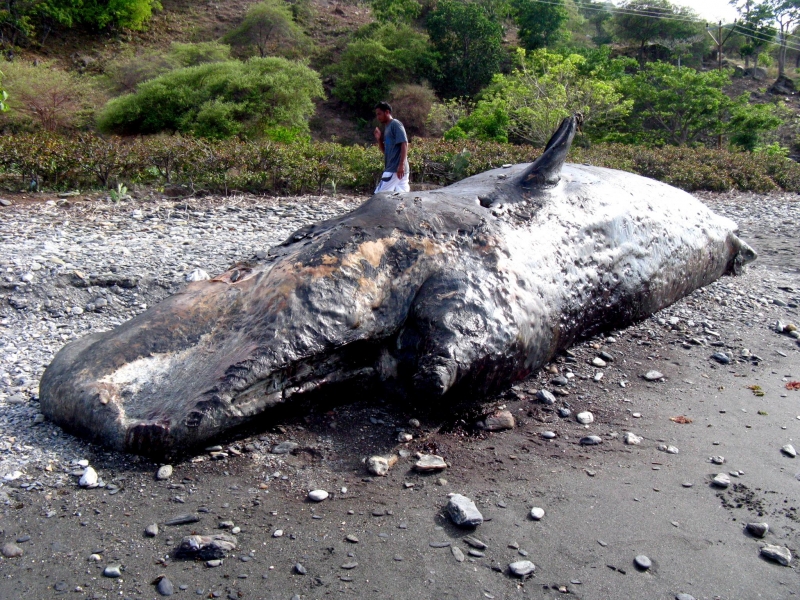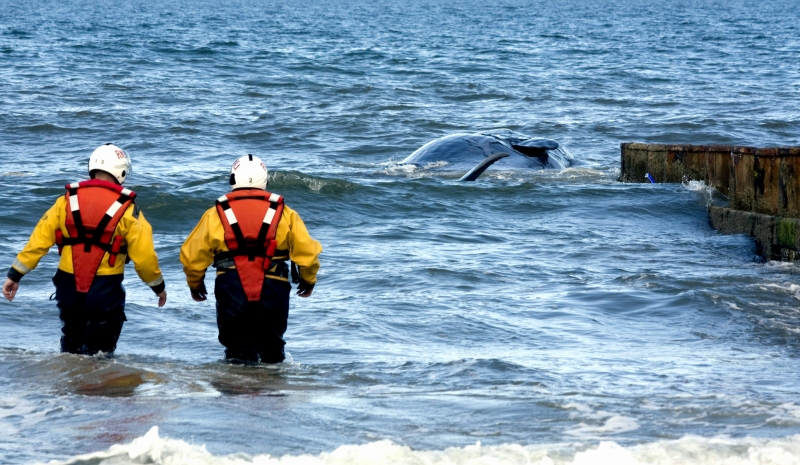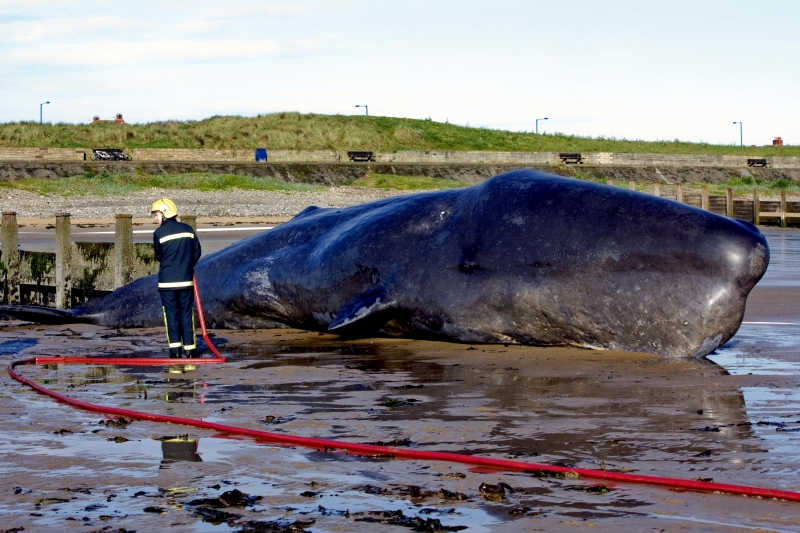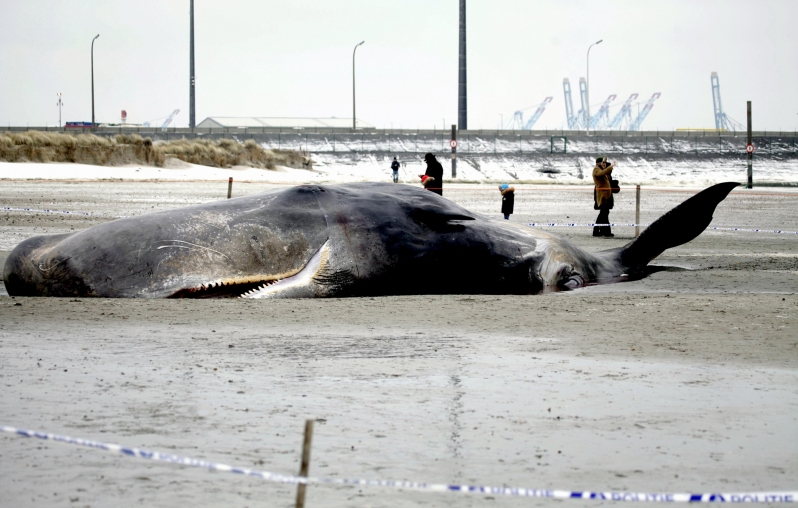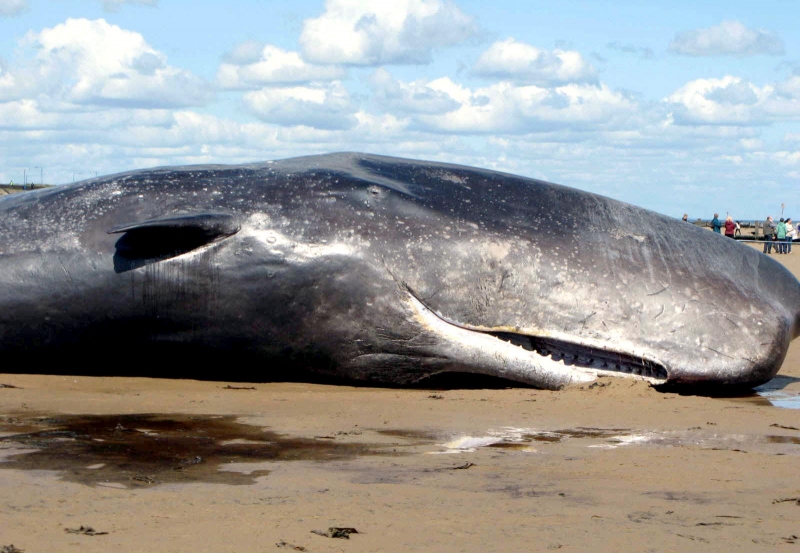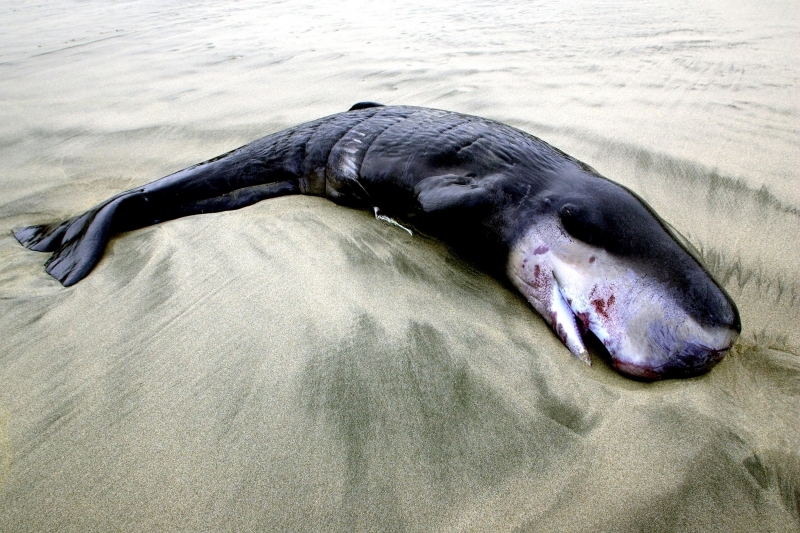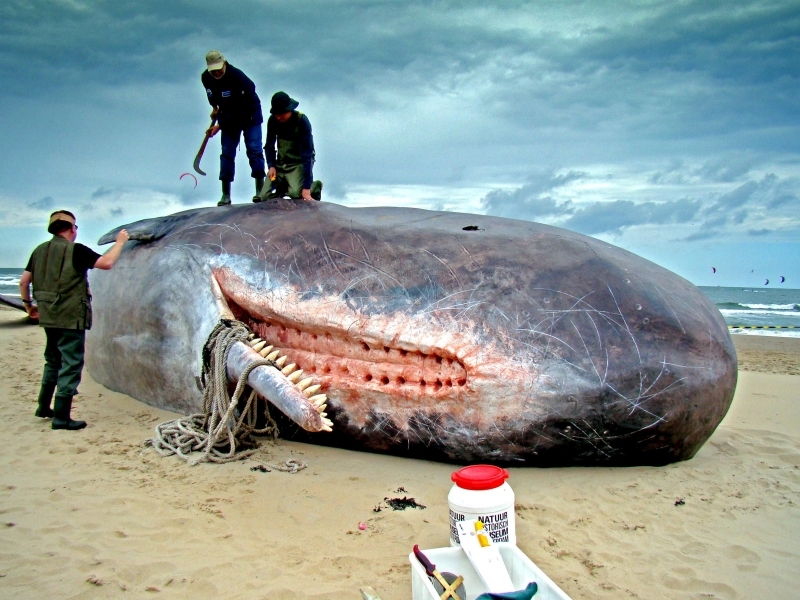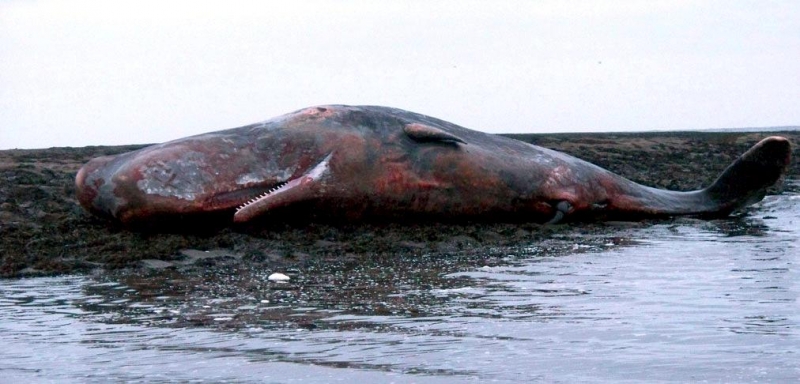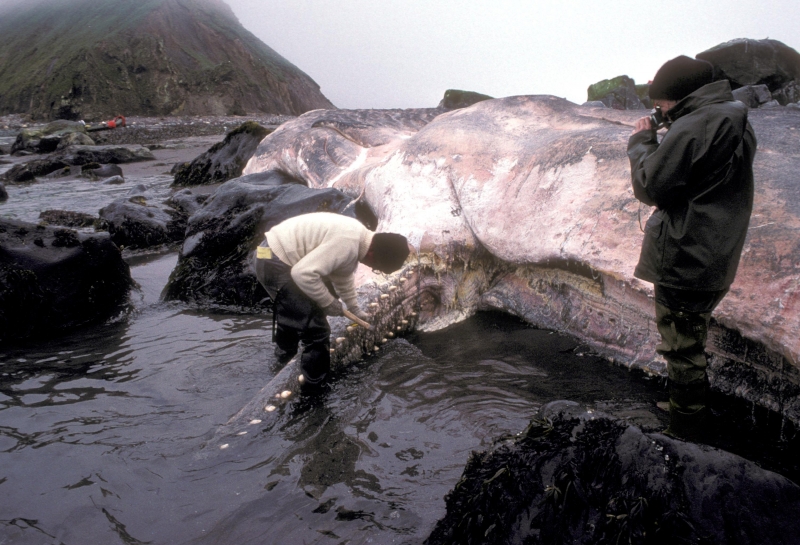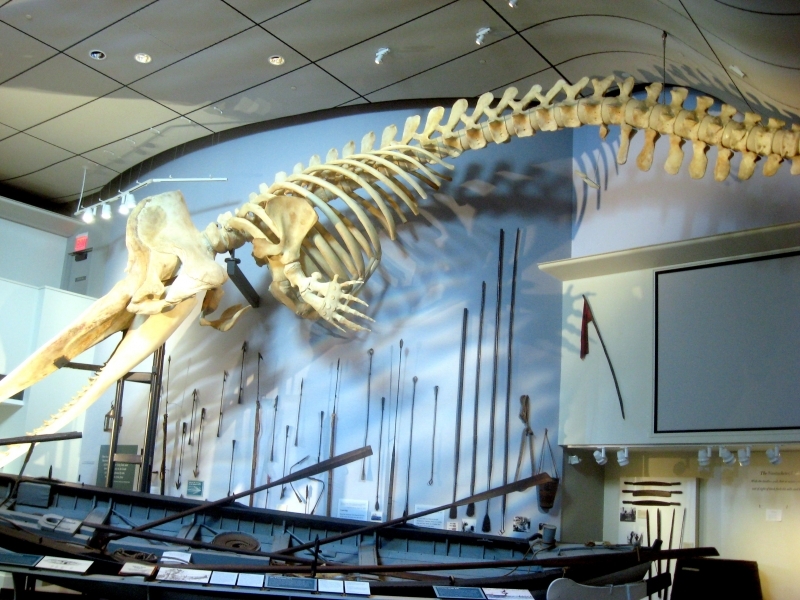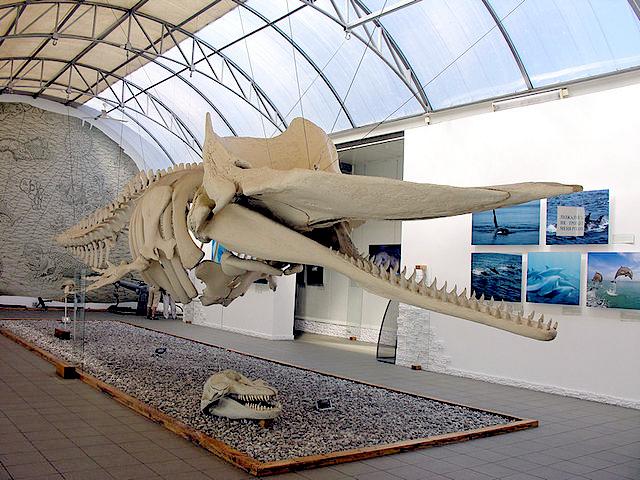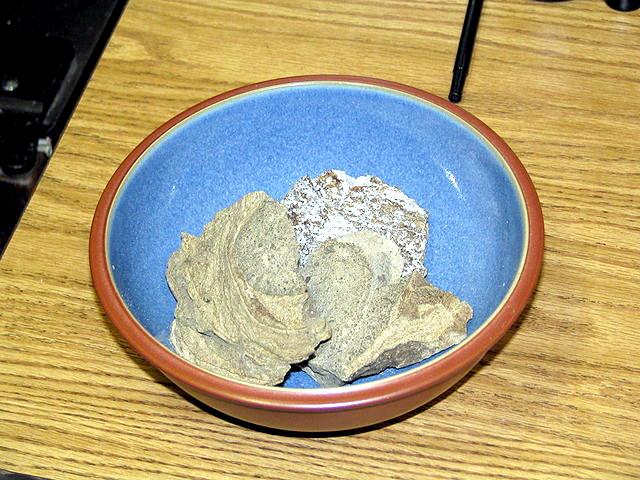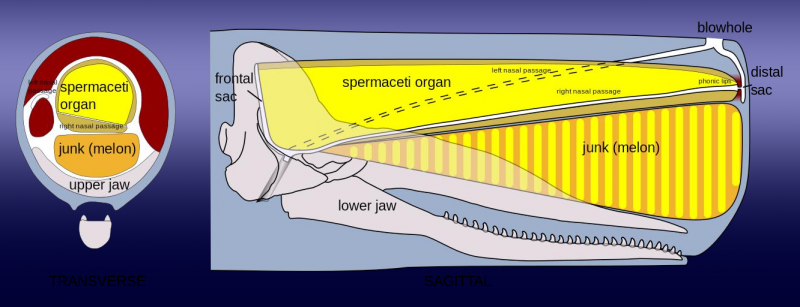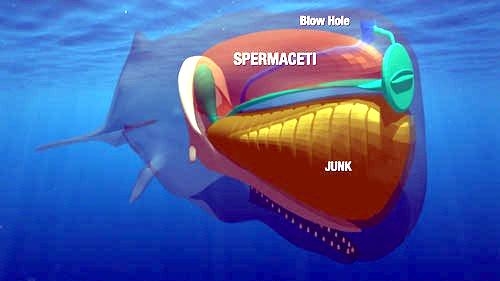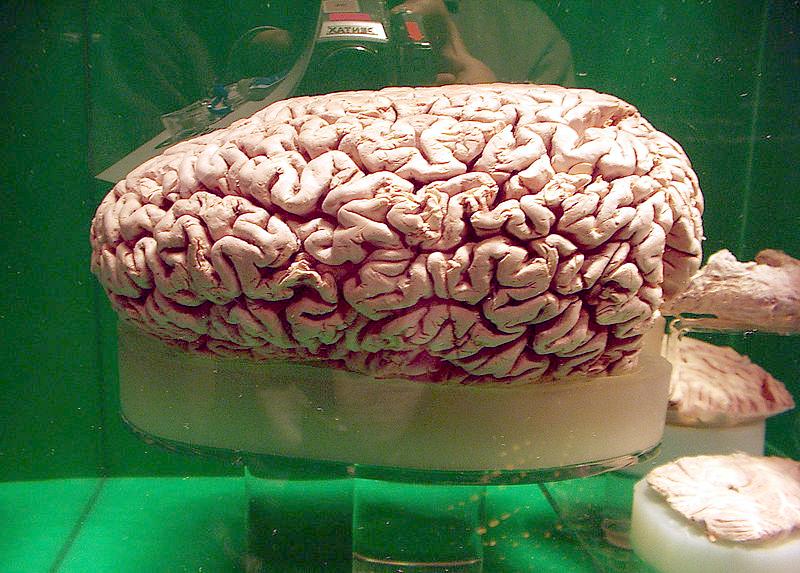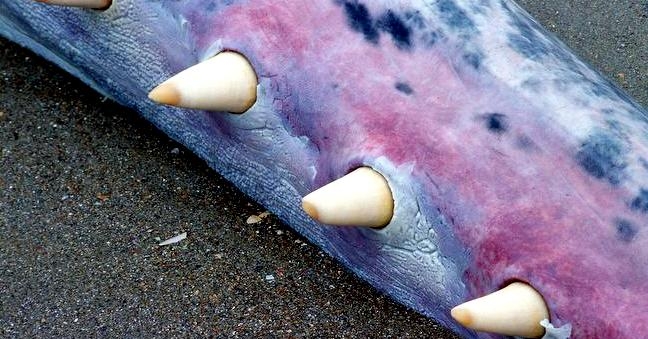“Physeter macrocephalus”
The Sperm Whale is the largest of the toothed whales. It has a huge brain that weighs about 20 pounds; it is the largest brain of any animal. The head of the whale contains a liquid wax called “spermaceti” from which the whale derives its name. Spermaceti was used in lubricants, oil lamps & candles. The Sperm Whale has a single blowhole that is s-shaped and about 20 inches long. The blowhole is located on the left side of the front if its huge head. The Sperm Whale has a 4-12 inch thick layer of blubber. Sperm Whales produce ambergris, a dark, waxy substance (related to cholesterol) that is produced in the lower intestines and is sometimes found containing squid beaks. Ambergris may help protect the Sperm Whale from the stings on the Giant Squid, its major food. Large lumps of ambergris may be vomited up by the Sperm Whale. Ambergris was extremely prized & expensive and was the main factor about the species that led to their large decline in population by the whaling industry. The fictional “Moby Dick” written by Herman Melville was a Sperm Whale. Adult males grow to be about 50-60 feet long, weighing about 40-50 tons. Females are smaller, about 33-40 feet long, weighing about 14-18 tons. The 4-chambered heart of the average Sperm Whale weighs about 277 pounds, about as much as 2 average adult human beings. The skin is usually dark gray to black, but is occasionally light gray. It has a distinctive, prune-like texture. Sperm Whales have the largest head of any animal which can be about 20 feet long, 10 feet high, 7 feet across and is about one-third of the whale’s body length. The head has a distinctive box-like shape and is frequently covered with circular scars that are made by the suckers of the Giant Squid that they hunt & eat.
It has 5-foot long flippers that are about 3 feet wide. There is no dorsal fin but there is a small hump two-thirds of the way down its back, also some ridges between the hump and the tail flukes. Sperm Whales are carnivores that mostly eat Giant Squid that live on the ocean bottom at great depths. They also eat fish, octopus and skate. In 1998 off the coast of Indonesia, 3 Sperm Whales were observed attacking a rare, filter feeding Megamouth Shark. An adult can eat about a ton (2,000 pounds) of food each day. Sperm Whale teeth are uniform. The teeth in the upper jaw never erupt. The teeth in the long, thin lower jaw are conical and huge, about 7 inches long. These teeth weigh about 2 pounds each. The lower jaw is about 16 feet long and has about 50-60 teeth in it. When the whale’s mouth is closed, the teeth fit into sockets in the upper jaw. The bonds between the members of Sperm Whale pods are strong & long-lasting. The members of a pod protect the young, the sick and the injured. Pods of females with their young are common and allows a mother to dive very deeply to hunt while leaving her young calf who is unable to dive very deeply, at the surface and protected by the pod.
Sperm Whales are the 2nd deepest diving of all cetaceans behind the record-breaking dives of the Cuvier’s Beaked Whale. Although they live at the surface they dive to hunt Giant Squid that are bottom dwellers. They have been known to dive as deeply as 10,500 feet, but average dives are about 4,000 feet deep. The Sperm Whale can hold its breath for about an hour. Sperm Whales breathe air at the surface of the water through a single, s-shaped blowhole. The blowhole is located on the left side of the front if its huge head. They spout (breathe) 3-5 times per minute at rest, but the rate increases to 6-7 times per minute after a dive. The blow is a noisy, single stream that rises up to 50 feet above the surface of the water and points forward and to the left of the whale at a 45° angle. Logging is when a whale lies still at the surface of the water resting, with its tail hanging down. While floating motionless, part of the head, the dorsal fin or parts of the back are exposed at the surface. Sperm Whales are often seen logging and are relatively easy to approach in this state. Sperm Whales also stick their tail out of the water into the air, swing it around and then slap it on the water’s surface; this is called “lobtailing” which produces a very loud sound. The meaning or purpose of lobtailing is unknown, but may be done as a warning to the rest of the pod or as some other type of communication. Sperm Whales use echolocation to catch their prey in the dark oceanic depths. Mothers also use this function to keep track of their young calf when they are diving to hunt as a calf cannot dive very deeply because it has to breathe much more frequently than the mother does. Sperm Whales are found in many open oceans, both in tropical and cool waters. Sperm Whales live at the surface of the ocean but dive very deeply to catch the Giant Squid. The Sperm Whale swims leisurely at the surface at about 3-9 mph but can sustain a faster pace when fleeing danger of 21-27 mph for up to an hour.
Sperm Whale breeding is not very dependent on the seasons. The gestation period is over 16 months and the calf is born tail first near the surface of the water. The newborn instinctively swims to the surface within 10 seconds for its first breath; it is helped by its mother. The newborn calf is about 13 feet long and weighs about 1 ton. Twins are extremely rare (about 1% of births); there is almost always 1 calf. The interval between births is about 3-4 years. A female reaches maturity at 9-10 years, (males reach maturity at 18-19 years) and lives to be about 40 years old. On average, a female will give birth to about 7-10 calves. Frequently, other whales “assist” in the birth. The baby is nurtured with its mother’s milk and is weaned in about 2 years. Calves drink 45 pounds of milk each day. Sperm Whales have a life expectancy of over 70 years. It is estimated that there are about 200,000 Sperm Whales world-wide and are considered an endangered species. These whales and many other large whales were over-hunted for many years, since their meat, oil and other body parts were very valuable. Since whale hunting has decreased in the last few decades, their populations are starting to recover. Sperm Whales are toothed whales of the suborder Odontoceti, although DNA analysis shows that the Sperm Whale is actually more closely related to the baleen whales. It is estimated that the historic worldwide Sperm Whale population numbered 1,100,000 before commercial whaling began in the early 18th century. By 1880, it had declined an estimated 29%. From that date until 1946, the population appears to have recovered somewhat as whaling pressure lessened but after the World War II with the industry’s focus again on Sperm Whales, the population declined even further to only 33%. It has been estimated that in the 19th century between 184,000 and 236,000 Sperm Whales were killed by the various whaling nations while in the modern era, at least 770,000 were taken the majority between 1946 and 1980.









